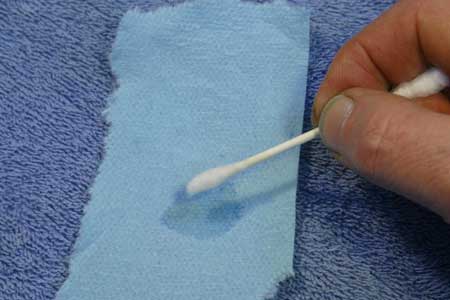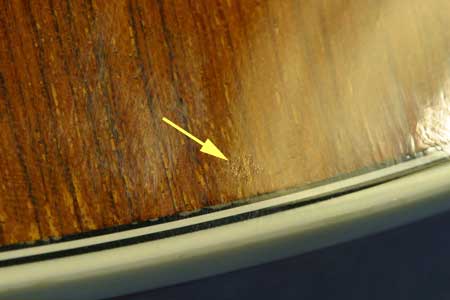A quick analysis
Testing Finish with Acetone
© Frank Ford 2003; Photos by FF
Modern instruments usually have fine polished finishes but it's often difficult
to tell the composition of the finish on a given instrument. Factories are constantly
changing materials and production methods, and smaller makers' instruments may
not turn up in the shop often enough for me to remember what kind of finish
they have.
This is a very simple little test that can be performed in an instant, and provided
that you're set up to polish out a tiny mark, it's safe and accurate for most
modern instruments. I spend a LOT of time touching up small dents, scratches,
dings and crack repair on various kinds of instruments, and have found this
to be a very effective diagnostic trick to use before I start!
Here's how I go about testing a finish to see if it is nitrocellulose lacquer
or a modern catalyzed polymer finish.
First, I dunk a cotton swab in some acetone, and blot it against a scrap of
paper towel so it is just moist, not drippy:

Then, LIGHTLY touching it to the surface of the finish in an
unobtrusive, easy to buff area, I'll see if it makes a mark like this:

Next, I'll wipe the mark with my finger to make sure it's really
an etched spot in the finish. If it is, the finish is nitrocellulose, and I'll
have a very tiny little that I'll need to buff to remove all traces:

Can you see that microscopically pitted area at the end of the
arrow? It's a sure sign that the finish is nitrocellulose lacquer, which is
readily soluble in acetone. If no spot remains, I'll try again, this time with
more acetone, just to make sure.
Acetone leaves no trace on many if not most of the new catalyzed
finishes, such as the finish on this Taylor guitar:

If the acetone swab makes a very slight mark that looks like a light haze, the
finish may be a French polished shellac. (Such a haze would look something like
the apparent haze in this little animated GIF. In this case it is really an
artifact of my photography.)
Back to Index Page



